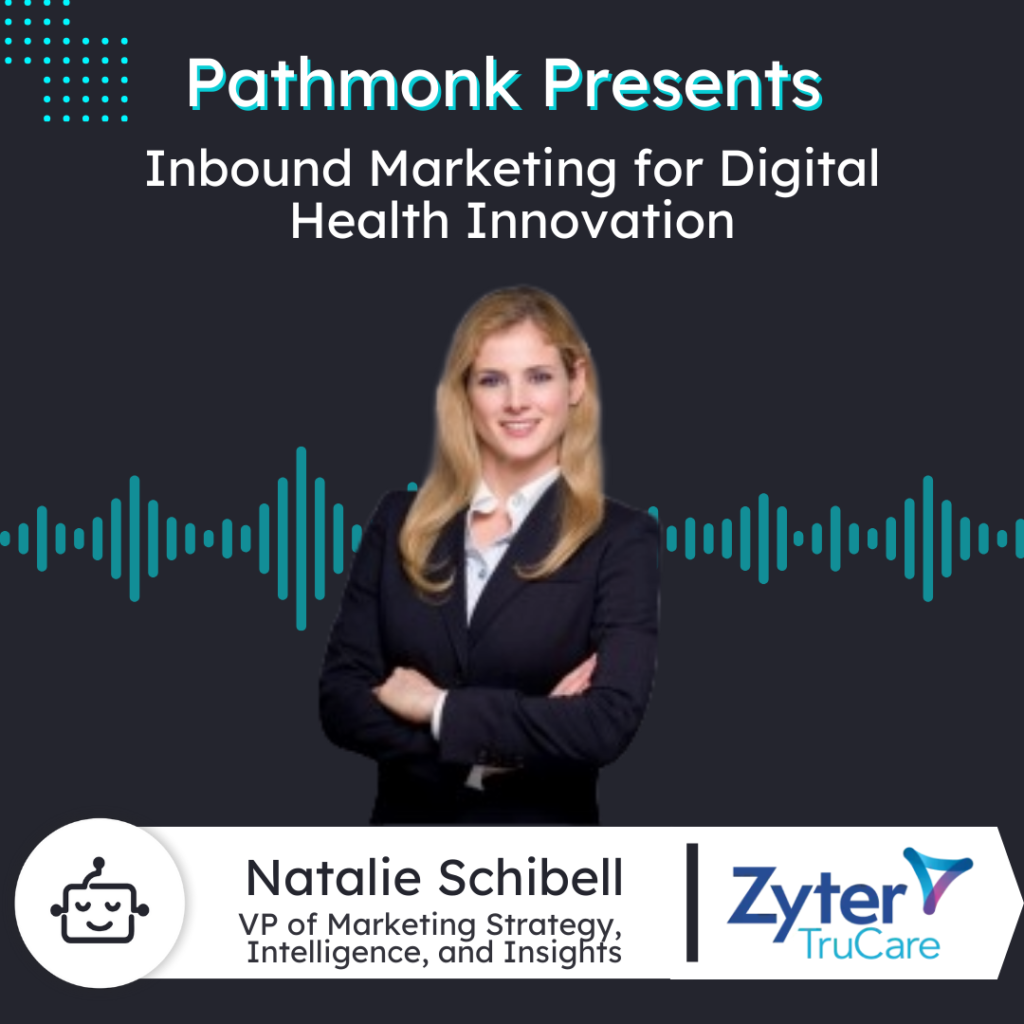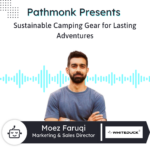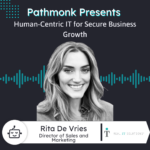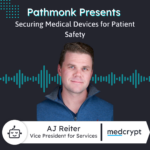
Introduction
In this insightful episode, we welcome Natalie Schibell, VP of Marketing Strategy, Intelligence and Insights at Zyter TruCare.
Natalie shares her expertise on how Zyter TruCare is revolutionizing care management through their comprehensive digital health platform. She discusses the challenges of managing complex patient populations, the importance of AI and analytics in healthcare, and strategies for effective inbound marketing in the healthcare sector.
Natalie also offers valuable insights on staying current in the rapidly evolving digital health landscape and the significance of thought leadership in building brand awareness and generating leads.
Increase +180%
leads
demos
sales
bookings
from your website with AI
Get more conversions from your existing website traffic delivering personalized experiences.

Ernesto Quezada: Pathmonk is the intelligent tool for website lead generation. With increasing online competition, over 98% of website visitors don’t convert. The ability to successfully show your value proposition and support visitors in their buying journey separates you from the competition online. Pathmonk qualifies and converts leads on your website by figuring out where they are in the buying journey and influencing them in key decision moments. With relevant micro-experiences like case studies, intro videos, and much more, stay relevant to your visitors and increase conversions by 50%. Add Pathmonk to your website in seconds. Let the AI do all the work and get access to 50% more qualified leads while you keep doing marketing and sales as usual. Check us on pathmonk.com. Welcome to today’s episode. Let’s talk about today’s guest. We have Natalie from Zyter, vice president of marketing strategy, intelligence, and insights with them. How are you doing today, Natalie?
Natalie Schibell: I’m doing excellent. How are you doing, Ernesto?
Ernesto: I’m doing great. Great. Thank you so much for asking, Natalie. And well, I’m sure, Natalie, our listeners are tuning in, wondering what Zyter is all about. So, in your own words, tell us a little bit more.
Natalie: Sure. So here at Zyter Truecare, we’ve been around for about a year. We are the combination of the purchase of Casenet by Zyter Inc. That happened a few years ago. We acquired Casenet, which is the developer of a platform called Truecare, well-known in the care management world, particularly in the payer space, and has been around since the nineties. So over 20 years of experience managing complex patients in the areas of utilization management, care case and disease management, appeals and grievances, and medication management. We’ve combined the name Zyter with Truecare, and we have Zyter Truecare. We are a company that serves over 45 million patients and members with our solutions. We’re unique in that we have a broad value proposition, providing applied AI, wrap-around services, and interoperability. That’s what makes us unique. We are more of a comprehensive digital health platform, as opposed to a single-point solution, which is needed with today’s complex patient and member populations. Six out of ten individuals have two or more chronic diseases, and four out of ten have at least one chronic disease. So, in this day and age, it becomes increasingly important, with an aging population and care shifting into the home environment, to have a comprehensive solution that can help coordinate care and manage these complex patients. That’s, in a nutshell, how Zyter Truecare is unique in what we offer in the market today.
Ernesto: That’s important. Okay. So that way, Natalie, our listeners can get a good understanding there, then. Zyter Truecare—what would you say is the key problem that you guys like to solve?
Natalie: You know, the key problem is more of a summary of many different problems in healthcare. Healthcare, of course, is highly regulated. It’s very complex. And we’ve moved, I would say, about a decade since COVID-19, with digital health technologies and the necessity to keep information and data secure, with HIPAA regulations and, of course, overseas GDPR regulations. You have to solve all those issues in a digital health platform. In addition to being able to stratify your population, understanding who’s high risk, who’s low risk, who needs more attention, and how to treat them best with technology, enabling our providers. We’re not actually the clinical providers; we enable them with these technology solutions. I’ll try to be brief, but there are lots of moving parts when it comes to managing complex patients and care management across the care continuum, from diagnosis to maintaining and improving their disease state. Lots of moving parts.
Ernesto: Okay, great. So then, I don’t want to assume here, Natalie, but would your ideal client be hospitals or… who is your client?
Natalie: Yeah, great question. Hospitals, as well as payers, and of course, the government. When you’re looking at population health and those who oversee healthcare for large populations, you’re dealing with a wide variety of buyer personas and customers. You’re looking at the government as well, such as the DoD. We have individuals insured by Tricare and, of course, public health entities in the government—CMS, Medicare, and Medicaid. So, it’s important to speak to all these different buyer personas and understand their pain points in terms of healthcare management and conditions.
Ernesto: Okay, great. Thank you so much. So then, how would somebody, say, in a hospital, find out about Zyter Truecare? Is there a top client acquisition channel for you?
Natalie: Yeah, that’s a great question. As a company with a brand new name, we have a product that’s tried and true for many years, but they may or may not know it. They will likely come to know us through the KLAS report, where we’ve been voted best in class for the Truecare platform in the past. They may also stumble upon our website. I’m sure we’ll talk more about how we use our website to increase brand awareness and ultimately bring in more leads and revenue. We are also heavily involved in thought leadership—keynote speaking, content creation, bylines published weekly, and subject matter experts featured in major healthcare publications. We are often featured in news articles. So, through a combination of all these things, we’re becoming more known. We also brief analysts, which is important to keep them up to date on our latest products and technology, as well as how we’re solving healthcare’s most complex problems.
Ernesto: Definitely important. And so, Natalie, for listeners who are tuned in and want to learn more, they can visit Zyter.com. What role does the website play in client acquisition?
Natalie: Great question. Our marketing team has been around for a year at Zyter Truecare, and one of my big focuses is on inbound marketing. We generate tons of content. Now that we have our marketing hub set up, we’re starting the fun part—getting that content onto the website, setting up contact forms, and getting people to opt-in or subscribe to our newsletters. These newsletters go to prospects, clients, analysts, and even internal audiences. That’s one prime way we get leads, along with conferences and events. We’re leaning heavily on thought leadership through blogs, white papers, and ebooks. Our strong clinical team, including nurses, a chief medical officer, and a chief clinical officer, who have worked in healthcare, provide us with great insights for creating content. They know the challenges firsthand and how technology can help. So, content and thought leadership are key parts of our strategy.
Ernesto: All right, great. Awesome. Thank you so much for sharing those awesome tips and strategies. Well, let’s shift gears a bit, Natalie, and talk about you as a leader. As the vice president of marketing strategy, intelligence, and insights, what are some key tasks you like to focus on in your day-to-day work?
Natalie: I have a really fun job because it’s not just in one swim lane. I have a non-traditional path for marketing. I started in healthcare. I was in the US Navy for twelve years, both active duty and as a reservist, with roles in population health management and human resources. After active duty, I worked at the Centers for Disease Control, contributing to the COVID-19 mitigation effort, and then moved to Forrester Research, working my way up to VP of research. I gained knowledge in market research and emerging technologies, which opened my eyes to what it takes to develop a successful product in today’s digital health world, especially post-COVID. Rapid advancements, the rise of consumerism, and the integration of AI and predictive analytics make this an exciting time. In my current role, I combine industry research, product insights, and long-term product roadmaps. I work closely with product teams, engineers, and sales to market our solutions effectively and drive leads. It’s a dynamic role that requires a well-rounded approach to marketing.
Ernesto: But I mean, you have a lot of insights. How do you usually stay up to date with all the news in the marketing world as far as strategies, trends, and updates?
Natalie: Definitely market research. We use a variety of resources. We are partners with KLAS, which I find very helpful when it comes to looking at competitors in the field and different segments. Forrester has great research as well, not just because I worked there, but because of the qualitative standpoint, differentiating one vendor from another. Gartner has its own flavor, and IDC also provides valuable insights. So, I spend a lot of time reading market research reports. Now, on the other side, I no longer have the advantage of sitting in product briefings as often as I did as an analyst. So, now I go the extra mile to gather that information from market research, talking to my own team members, and understanding things more deeply from the product perspective. I attend sprint meetings to get the latest updates on value propositions and product development. I also talk to our nurses to break down complex topics like utilization management. It’s a collective effort to stay informed and keep the marketing strategy sharp.
Ernesto: Awesome. Thank you so much for sharing that with us and for our listeners. Well, Natalie, let’s jump into our rapid-fire question round. Are you ready for them?
Natalie: Always ready.
Ernesto: Awesome. First up, what is the last book that you read?
Natalie: Oh, my goodness. I’ve been so deep in product and research articles lately that my actual book reading has taken a back seat. But the last book I recall reading was by David Goggins. He’s a former Navy SEAL and an incredible human being. His story is truly phenomenal. He talks about how most people only work to 40% of their potential, and I’m a big believer in that. It’s not about where you started but how you finish. If you put in the time and effort, you can achieve great things, regardless of your background or IQ. It’s about working hard and smart, pushing through challenges, and getting to that last 20% of your true potential. I highly recommend his book—it’s incredibly inspiring.
Ernesto: Yep, I’ve heard great things about that book. I’ll have to check it out. Next question, Natalie: If you could automate one repetitive task in your role, what would it be?
Natalie: That’s a tricky one. Marketing isn’t always repetitive because things change so fast, and if you go on autopilot, you miss things. But we do a lot of social media posting, and there are ways to automate that with tools like ChatGPT or other AI tools to help generate posts. However, I think if you automate too much, you risk losing the personal touch. It’s important to stay in tune with what you’re putting out there and ensure it aligns with the latest trends and topics.
Ernesto: I love what you said. Some people are eager to automate everything, but like you mentioned, there’s value in staying hands-on to avoid missing important opportunities. Great insight! If there were no boundaries in technology, what would be the one thing you’d want to innovate for your role as a marketer?
Natalie: Technology is amazing. It has certainly made me more productive. Generative AI, like ChatGPT, has increased my productivity by 400%. I need to know about so many facets of bringing a product to market, and AI helps fill in gaps quickly. It’s humbling because there’s so much to learn, but AI allows me to get answers in a pinch, whether it’s understanding an acronym or how one concept connects to another. That said, AI is just a tool. The key is taking that knowledge and translating it into a strategic plan that drives results. Technology helps, but the strategy and execution still require experience and creativity.
Ernesto: Absolutely. It’s all about balancing the tools with strategic thinking. Lastly, Natalie, with all your experience in marketing, what’s one piece of advice you’d give yourself if you were starting your marketing journey today?
Natalie: Marketing is a combination of many different skills and topics. If I could go back, I might have taken some marketing courses in college or pursued an MBA or MPH. But my non-traditional path has also given me an advantage in understanding healthcare and population management. My advice would be to stay well-rounded. Don’t stay in one lane. Learn from different areas, especially in healthcare. Work in a hospital setting, get involved in research, and be driven by curiosity. Always be motivated to learn because things are constantly changing, especially with technology. If you’re not learning, you’re falling behind. So stay ahead of the game, keep growing, and always look for new opportunities to expand your knowledge.
Ernesto: That’s excellent advice, not just for yourself but for every listener out there. Thank you so much for sharing, Natalie. Before we wrap up, what’s the one thing you want our listeners to remember about Zyter Truecare?
Natalie: There’s a lot to know, but the key takeaway is this: When choosing a healthcare solution, look at the people behind it. Look at their experience and background. At Zyter Truecare, we don’t just know technology—we understand healthcare inside and out. Our team has real-world experience with the challenges of healthcare, and we build products that solve those challenges. Choose a company that not only delivers great technology but also understands the workflows and goals of healthcare providers and patients. That’s what sets us apart.
Ernesto: That’s a great point. Thank you so much for sharing, Natalie. And for our listeners, you can check out Zyter at zyter.com.











